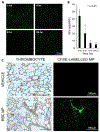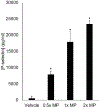Microparticles from aged packed red blood cell units stimulate pulmonary microthrombus formation via P-selectin
- PMID: 31821908
- PMCID: PMC7061313
- DOI: 10.1016/j.thromres.2019.11.028
Microparticles from aged packed red blood cell units stimulate pulmonary microthrombus formation via P-selectin
Abstract
Introduction: During storage, packed red blood cells undergo a series of physical, metabolic, and chemical changes collectively known as the red blood cell storage lesion. One key component of the red blood cell storage lesion is the accumulation of microparticles, which are submicron vesicles shed from erythrocytes as part of the aging process. Previous studies from our laboratory indicate that transfusion of these microparticles leads to lung injury, but the mechanism underlying this process is unknown. In the present study, we hypothesized that microparticles from aged packed red blood cell units induce pulmonary thrombosis.
Materials and methods: Leukoreduced, platelet-depleted, murine packed red blood cells (pRBCS) were prepared then stored for up to 14 days. Microparticles were isolated from stored units via high-speed centrifugation. Mice were transfused with microparticles. The presence of pulmonary microthrombi was determined with light microscopy, Martius Scarlet Blue, and thrombocyte stains. In additional studies microparticles were labelled with CFSE prior to injection. Murine lung endothelial cells were cultured and P-selectin concentrations determined by ELISA. In subsequent studies, P-selectin was inhibited by PSI-697 injection prior to transfusion.
Results: We observed an increase in microthrombi formation in lung vasculature in mice receiving microparticles from stored packed red blood cell units as compared with controls. These microthrombi contained platelets, fibrin, and microparticles. Treatment of cultured lung endothelial cells with microparticles led to increased P-selectin in the media. Treatment of mice with a P-selectin inhibitor prior to microparticle infusion decreased microthrombi formation.
Conclusions: These data suggest that microparticles isolated from aged packed red blood cell units promote the development of pulmonary microthrombi in a murine model of transfusion. This pro-thrombotic event appears to be mediated by P-selectin.
Keywords: Endothelial activation; P-selectin; Pulmonary thrombus; RBC microparticles.
Copyright © 2019 Elsevier Ltd. All rights reserved.
Conflict of interest statement
Figures





Similar articles
-
Microvesicles from stored red blood cells induce P-selectin and von Willebrand factor release from endothelial cells via a protein kinase C-dependent mechanism.Transfus Apher Sci. 2024 Apr;63(2):103890. doi: 10.1016/j.transci.2024.103890. Epub 2024 Feb 5. Transfus Apher Sci. 2024. PMID: 38355315 Free PMC article.
-
Endocytosis of Red Blood Cell Microparticles by Pulmonary Endothelial Cells is Mediated By Rab5.Shock. 2018 Mar;49(3):288-294. doi: 10.1097/SHK.0000000000000995. Shock. 2018. PMID: 29438268 Free PMC article.
-
Microparticles from stored red blood cells promote a hypercoagulable state in a murine model of transfusion.Surgery. 2018 Feb;163(2):423-429. doi: 10.1016/j.surg.2017.09.028. Epub 2017 Nov 29. Surgery. 2018. PMID: 29198748 Free PMC article.
-
Analysis and clinical relevance of microparticles from red blood cells.Curr Opin Hematol. 2010 Nov;17(6):571-7. doi: 10.1097/moh.0b013e32833ec217. Curr Opin Hematol. 2010. PMID: 20960973 Review.
-
The role of microparticles in chronic obstructive pulmonary disease.Int J Chron Obstruct Pulmon Dis. 2014 Mar 27;9:303-14. doi: 10.2147/COPD.S38931. eCollection 2014. Int J Chron Obstruct Pulmon Dis. 2014. PMID: 24707174 Free PMC article. Review.
Cited by
-
Storage of packed red blood cells impairs an inherent coagulation property of erythrocytes.Front Physiol. 2022 Nov 25;13:1021553. doi: 10.3389/fphys.2022.1021553. eCollection 2022. Front Physiol. 2022. PMID: 36505041 Free PMC article.
-
The in vitro red blood cell microvesiculation exerts procoagulant activity of blood cell storage in Southeast Asian ovalocytosis.Heliyon. 2022 Dec 30;9(1):e12714. doi: 10.1016/j.heliyon.2022.e12714. eCollection 2023 Jan. Heliyon. 2022. PMID: 36632113 Free PMC article.
-
LncRNA MSTRG.22719.16 mediates the reduction of enoxaparin sodium high-viscosity bone cement-induced thrombosis by targeting the ocu-miR-326-5p/CD40 axis.J Orthop Surg Res. 2023 Sep 22;18(1):716. doi: 10.1186/s13018-023-04109-5. J Orthop Surg Res. 2023. PMID: 37736740 Free PMC article.
-
Donor-dependent aging of young and old red blood cell subpopulations: Metabolic and functional heterogeneity.Transfusion. 2020 Nov;60(11):2633-2646. doi: 10.1111/trf.16017. Epub 2020 Aug 19. Transfusion. 2020. PMID: 32812244 Free PMC article.
-
High expression of P-selectin induces neutrophil extracellular traps via the PSGL-1/Syk/Ca2+/PAD4 pathway to exacerbate acute pancreatitis.Front Immunol. 2023 Sep 28;14:1265344. doi: 10.3389/fimmu.2023.1265344. eCollection 2023. Front Immunol. 2023. PMID: 37841279 Free PMC article.
References
-
- Rhee P, Joseph B, Pandit V, et al. Increasing trauma deaths in the United States. Ann Surg. 2014;260(1):13–21. - PubMed
-
- Evans JA, van Wessem KJ, McDougall D, Lee KA, Lyons T, Balogh ZJ. Epidemiology of traumatic deaths: comprehensive population-based assessment. World J Surg. 2010;34(1):158–163. - PubMed
-
- Kauvar DS, Lefering R, Wade CE. Impact of hemorrhage on trauma outcome: an overview of epidemiology, clinical presentations, and therapeutic considerations. J Trauma. 2006;60(6 Suppl):S3–11. - PubMed
-
- Sauaia A, Moore FA, Moore EE, et al. Epidemiology of trauma deaths: a reassessment. J Trauma. 1995;38(2):185–193. - PubMed
Publication types
MeSH terms
Substances
Grants and funding
LinkOut - more resources
Full Text Sources
Medical

